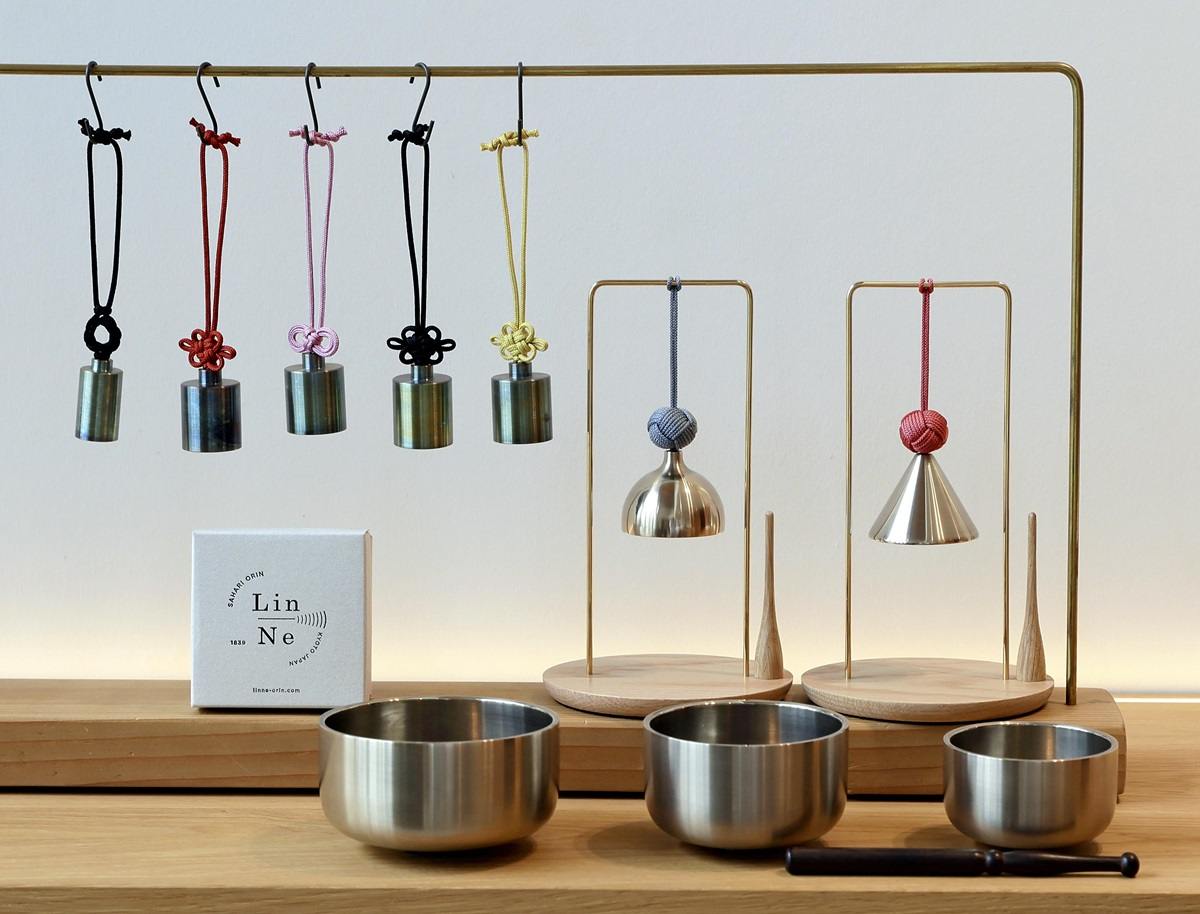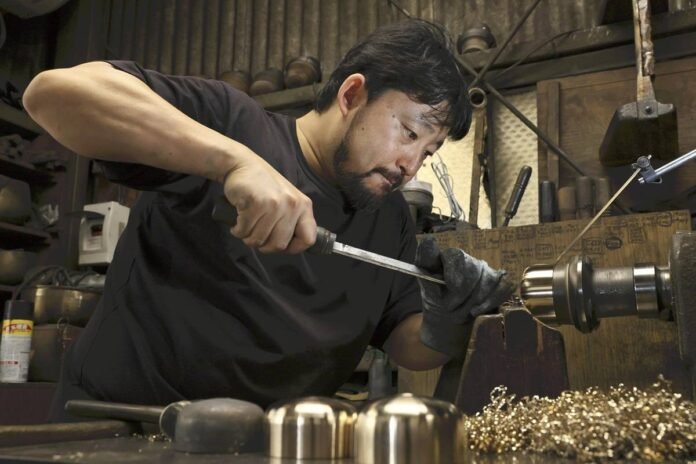Kazuya Nanjo carves an orin in Uji, Kyoto Prefecture.

11:01 JST, July 6, 2024
UJI, Kyoto — Orin metal bowls, used in Buddhist rituals and ceremonies, produce a clean, clear high-pitched sound when struck. The purifying sound stretches out as if reverberating in the ears.
The orin made by Kazuya Nanjo transcend the conventional framework of Buddhist implements. They touch people’s hearts even when they are used in interior decoration or as a musical instrument.
Nanjo is the seventh-generation owner of Nanjo Kobo Ltd. in Uji, Kyoto Prefecture, a company that produces musical instruments used in shrines and temples in Kyoto.
The process of making the products is the opposite of the clean sound they make. Black smoke billows upwards and sparks of fire dance in the workshop as an alloy called sahari, bright red at over 1,300 C, is poured into molds that are fired with wood. Sahari is a mixture of copper and tin.

Left: The flame turns greenish when copper, the raw material for sahari, is poured into the pot. Right: Molds are fired with wood.
After casting the sahari, Nanjo splits the molds by pouring water over them and polishes the surface of the orin with a file. The thickness of the orin must be uniform to ensure that they do not produce unstable sound. Otherwise, they are put back into the fire.
Nanjo said that the slightest differences in the weather, his own physical condition, and the heat of the tools in his hands all affect the outcome of his creations. Orin created by Nanjo through this elaborate process emit a sustained sound that fills the niche between silence and eloquence.
“I take risks with all my efforts against the forces of nature. Whether it works or not depends on my experience and intuition,” Nanjo said.
Continuing the tradition
Nanjo Kobo was founded around 1830. In addition to orin, the company also makes hand gongs for the Gion Festival in July and other musical instruments.

A traditional original, foreground and LinNe product
Nanjo, a former chef, first visited Nanjo Kobo’s workshop, his wife’s family home, about 20 years ago when he was 23. Nanjo said everything he saw there was new to him.
Among them were the flames of sahari, which change from orange and blue to green depending on the temperature, and the piercing sound of shining orin. Fascinated by the challenge of reproducing a unique sound with his own hands, Nanjo began working there.
Of course, he had to wander around the workshop a bit in the beginning. Although his older colleagues and his father-in-law, the sixth owner of Nanjo Kobo, taught him how to make orin, he could not produce the sound he wanted.
Still, Nanjo said, it was fun. He found it interesting to keep working while wondering what kind of sound he could produce. He decided to continue the tradition of making orin, even though the industry was in decline due to changing lifestyles.
His father-in-law, who was planning to close the business, repeatedly asked Nanjo if he was sure to take over. But Nanjo never hesitated, because he was determined to make the ideal sound.
Data collection
Generally, sahari is made up of 80%-85% copper and 20%-15% tin. However, the fifth-generation owner of Nanjo Kobo created a unique ratio that pushes the tin ratio to the limit, increasing the hardness of sahari and creating a distinctive sound.

Molten sahari, an alloy of copper and tin, is poured into a mold.
However, the ratio works against the metals’ tendency to warp. When spinning and carving to shape them, even the slightest bit of over-carving caused the alloy shells to repeatedly break like glass.
In order not to rely too much on instinct, Nanjo recorded each time he cast, collecting numerical and other concrete information about the size, time of casting the alloy, and weather conditions to show under what circumstances success would occur. The information and experiences collected further sharpened his intuition as a craftsman.
Everyday use
Nanjo also began efforts to expand the capabilities of the orin. Five years ago, he developed “LinNe,” a palm-sized orin with a diameter of 2 to 3 centimeters, to provide “a good sound for daily life.”
LinNe comes in different musical scales and its use is up to the users. For example, it can be used as a doorbell or to calm yourself down. The late musician Ryuichi Sakamoto also loved using LinNe.

Baking on a hot iron plate brings out the bright colours of the orin to its best advantage.
The Orin produces “a sound I have never heard before” and “a sound that penetrates my mind,” were some of the comments Nanjo received from customers of a wide age group.
“What we’re making is not a work of art. It’s important to create sounds that are useful to users,” Nanjo said. The world is filled with a variety of sounds, and the sounds people need are different from person to person.
“That’s why it’s so rewarding to make orin. I want to pursue the sound that people want.”
It has only been a few months since Nanjo became the seventh owner. He is willing to bring a new perspective to the industry and connect people with tradition through sound.
***
If you are interested in the original Japanese version of this story, Click here.



